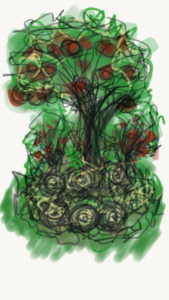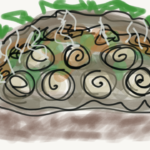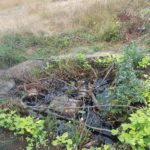
What is an ecological garden, and what makes it special? These kinds of gardens do more than just use eco-sensitive techniques, they are designed communities of plants and animals that work together to fill niches that would otherwise be occupied by undesirables, and increase fertility and abundance of soil and species. They can be set up on a solid foundation of organic material that absorbs a season’s worth of water and slowly releases it to your plants as it becomes rich food for the ecosystem.
Systems can be set up overnight or built up slowly, surrounding and enhancing existing features of your land. Perennial pioneer species can be found and encouraged with organic matter like sticks and mulch, and more space for more species can be established.
Every piece of land is a little different. A map can be made of your site’s advantageous features and disadvantages, a plan made for how to accentuate the good and deal with the bad, all the while increasing your space’s threshold for reliably producing food for you.

In my experience animals are a critical part of every garden; gardening methods like hugulkultur (fresh and decomposing matter and dirt thrown over fresh logs piled in a shallow pit and built into a raised mound) tends to create habitat for toads and other small animals that form the basis for a thriving ecosystem which keeps nutrients coming to your food plants, and on-the-ground pest control, free of charge.

You can intentionally plant certain species to attract certain insects and other animals, and ones that feed your own animals, such as chickens, for free. I sow handfuls of beans that are too old to soak and eat into the landscaping at the edge of my beds, and this results in endless fresh bean sprouts for my chickens to tear apart.
These are just a smattering of ideas and remember, every site is unique. The approach for your place might be completely different and awesome in its own way. If you want to talk about your place and ideas, call me for a free one-hour consultation to see if an ecological garden design will work for you!
